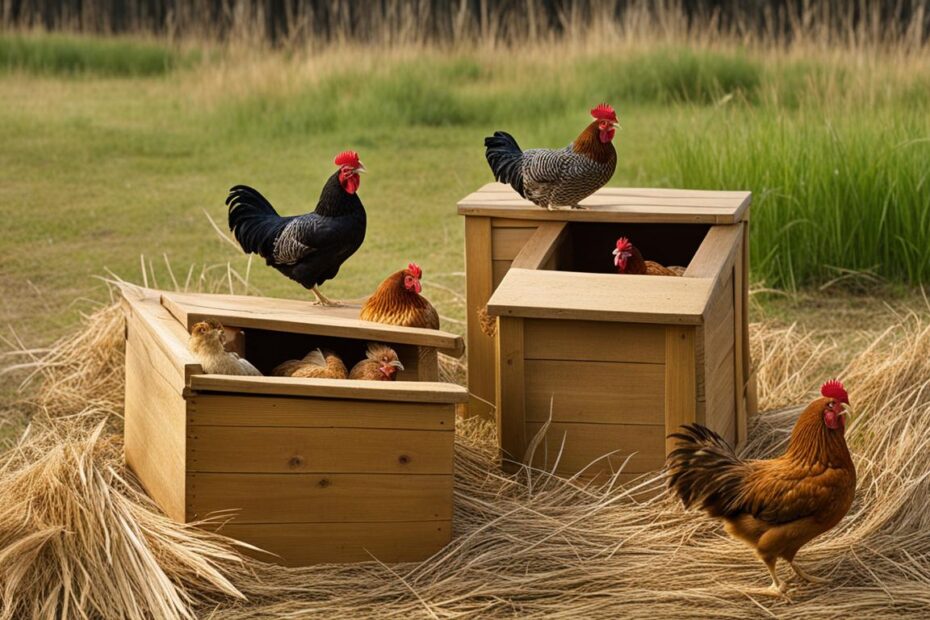When it comes to raising chickens, providing suitable nesting boxes is an essential part of creating a comfortable environment for your flock. But how many nesting boxes do you actually need for six chickens? Let’s delve into the requirements and factors to consider when deciding on the optimal number of nesting boxes for your feathered friends.
Key Takeaways:
- The general rule of thumb is to provide one nesting box for every three to four hens.
- For a flock of 6 chickens, it is recommended to have at least two nesting boxes as a bare minimum.
- Factors such as breed and egg-laying patterns affect the number of nesting boxes needed.
- Choose the appropriate size of nesting boxes based on the size of your chickens.
- Consider training your chickens to use the nesting boxes and providing the right bedding materials.
Factors Affecting Nesting Box Quantity
When determining the optimal number of nesting boxes for your chickens, several factors come into play. It’s important to consider the breeds of chickens you have and their egg-laying patterns. Not all breeds lay eggs every day or even every other day, so their individual needs should be taken into account. Additionally, chickens have a tendency to develop preferences for certain nesting boxes and will often choose to use the same box even if other options are available. As a result, increasing the number of nesting boxes may not be necessary if all the hens are using the same box.
By observing the behavior of your flock and monitoring their egg-laying patterns, you can determine the appropriate number of nesting boxes. It’s important to strike a balance between providing enough nesting space and avoiding unnecessary overcrowding. Providing too few nesting boxes can result in hens competing for limited space, which may lead to stress and reduced egg production. On the other hand, providing too many nesting boxes can be wasteful and may not be utilized by the chickens. Therefore, it’s recommended to closely monitor your flock and adjust the number of nesting boxes accordingly.
While the general guideline of one nesting box for every three to four hens is a good starting point, it’s essential to consider the specific needs and behaviors of your chickens. By providing an adequate number of nesting boxes, you can ensure that your chickens have comfortable and suitable areas for laying their eggs, promoting their overall well-being and egg production.
| Factors | Influence on Nesting Box Quantity |
|---|---|
| Breed | Different breeds have varied egg-laying patterns and preferences for nesting boxes. Consider the specific needs of your breed when determining the number of nesting boxes required. |
| Egg-Laying Patterns | Not all chickens lay eggs every day or even every other day. Take into account the frequency of egg laying to determine the appropriate number of nesting boxes. |
| Nesting Box Preferences | Chickens often develop preferences for certain nesting boxes and will choose to use the same box even if others are available. Assess the behavior of your flock to understand their preferences and adjust the number of nesting boxes accordingly. |
| Flock Size | The size of your flock will also impact the number of nesting boxes needed. Larger flocks may require more nesting boxes to ensure adequate space for all hens to lay their eggs comfortably. |
Nesting Box Size and Bedding Requirements
When it comes to nesting boxes for chickens, size matters. The size of the nesting boxes should be appropriate for the size of your chickens. For standard-sized chickens, a common guideline is to have nesting boxes that are 12″x12″x12″ inches in size. However, smaller breeds like Bantams can have smaller boxes, while larger breeds like Orpingtons may require bigger boxes. It is important to provide enough space for the hens to comfortably enter and move around in the nesting box.
In addition to the size, the bedding inside the nesting boxes is crucial for creating a comfortable and inviting environment for your hens. Common bedding materials for nesting boxes include wood shavings, hay, straw, grass clippings, and nesting box pads. These materials help to absorb moisture, provide insulation, and cushion the eggs. Regularly cleaning and replacing the bedding will help keep the nesting area clean and prevent the buildup of bacteria or parasites.
It is also important to create a dark and secluded environment for the hens to lay their eggs. This can be achieved by covering the nesting boxes or using nesting box curtains. The darkness helps to mimic the natural instinct of hens to seek privacy and security when laying eggs. By providing the right size nesting boxes and suitable bedding, you can ensure that your chickens have comfortable and inviting nesting areas to lay their eggs.
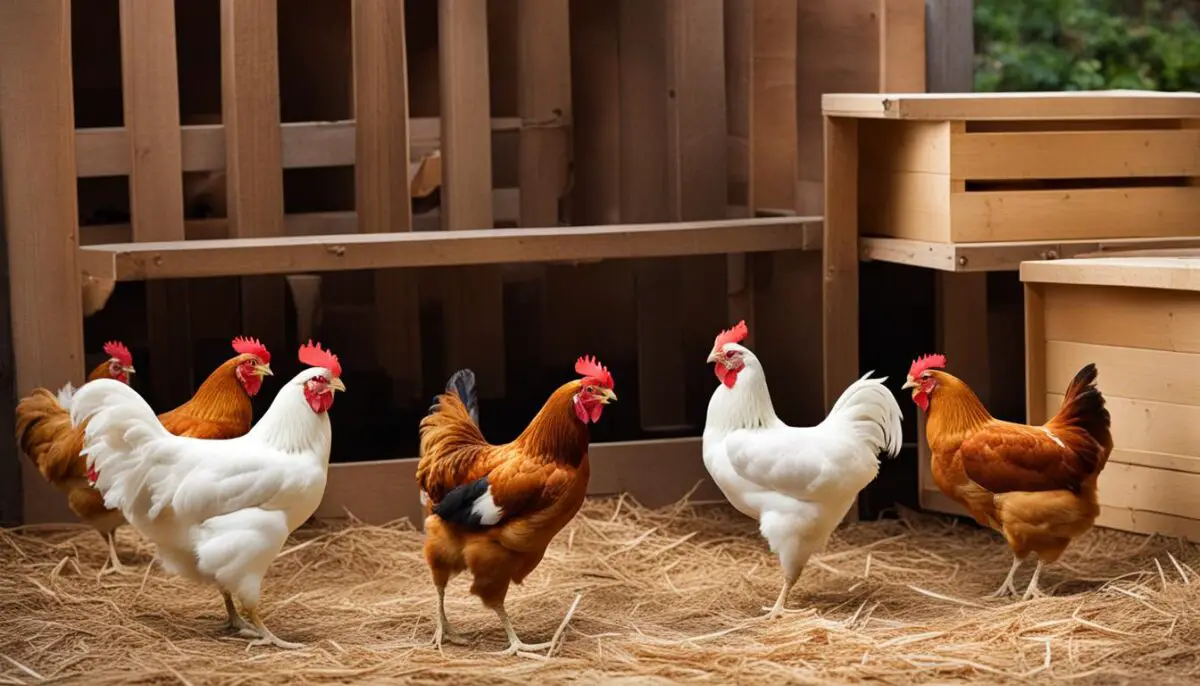
Table: Recommended Nesting Box Sizes
| Chicken Breed | Nesting Box Size (in inches) |
|---|---|
| Bantam | 10x10x12 |
| Standard | 12x12x14 |
| Heavy | 14x12x14 |
Note: These are general recommendations and can vary depending on the specific needs of your chickens. It is important to observe your flock and adjust the nesting box sizes accordingly, especially if you have different breeds with varying sizes.
Training Chickens to Use Nesting Boxes
Training chickens to use nesting boxes is an essential step to ensure that your hens lay their eggs in a designated area, preventing cracked or dirty eggs. Young laying hens may not instinctively understand where to lay their eggs, so it’s important to provide them with the proper guidance and environment.
One effective method is to create a dark and safe environment in the nesting boxes. Chickens prefer to lay their eggs in dark and secluded areas, so covering the nesting boxes or using nesting box curtains can encourage them to use the boxes for laying.
Another helpful tip is to place fake eggs, such as golf balls or hard-boiled eggs, in the nesting boxes. Chickens are naturally drawn to lay their eggs where they see existing eggs. By placing the fake eggs in the boxes, you can encourage your hens to use them for nesting.
Additionally, gradually blocking access to unwanted places where the hens tend to lay, such as sandy areas or under bushes, can also prompt them to use the nesting boxes. This can be achieved by using a temporary fence or barrier to restrict their access and gently guiding them towards the designated nesting area.
Table: Tips for Training Chickens to Use Nesting Boxes
| Tip | Description |
|---|---|
| Create a dark and safe environment | Cover the nesting boxes or use curtains to provide privacy and security for the hens. |
| Place fake eggs in the nesting boxes | Use golf balls or hard-boiled eggs to show the hens where to lay their eggs. |
| Gradually block access to unwanted areas | Restrict the hens’ access to places they tend to lay outside of the nesting boxes. |
By following these training methods, you can encourage your chickens to use the nesting boxes and establish a consistent and convenient location for egg-laying. Training may take some time and patience, but with proper guidance, your hens will learn to use the nesting boxes reliably.
Different Types of Nesting Box Designs
When it comes to designing nesting boxes for chickens, there are several options to choose from. Each design has its own advantages and considerations, allowing you to find the best fit for your flock. Here are some of the different types of nesting box designs:
Individual Nesting Boxes
Individual nesting boxes are the most common and preferred style for chickens. These boxes provide privacy for each hen, allowing them to lay their eggs in peace. The individual design helps to prevent other hens from disturbing the laying process and reduces the likelihood of cracked or dirty eggs. It also makes egg collection easier, as each box can be accessed separately.
Group Nesting Boxes
If you have a larger flock of chickens, group nesting boxes can be a good option. These boxes are designed to accommodate multiple hens at once, allowing them to lay their eggs together. Group nests can be particularly useful if your chickens have a similar laying schedule, as it reduces the chances of one hen dominating a nesting box. They also make egg collection more efficient, as all the eggs are located in one central area.
Rollaway Nests
Rollaway nests are a popular choice for chicken owners who want to keep their eggs clean and prevent broodiness. These nests have a slanted surface that allows the eggs to roll away into a protected tray or compartment. This design keeps the eggs separate from the chickens, reducing the chances of them getting dirty or broken. Rollaway nests are especially beneficial for maintaining egg hygiene and improving hatchability.
Trap Nests
Trap nests are primarily used in breeding programs or when it is necessary to identify which hen lays which egg. These nests have a special mechanism that locks the hen inside after she enters to lay her egg. This allows you to track the laying patterns and productivity of individual hens. Trap nests are often used by poultry breeders or researchers to gather data on egg quality, laying frequency, and other important breeding traits.
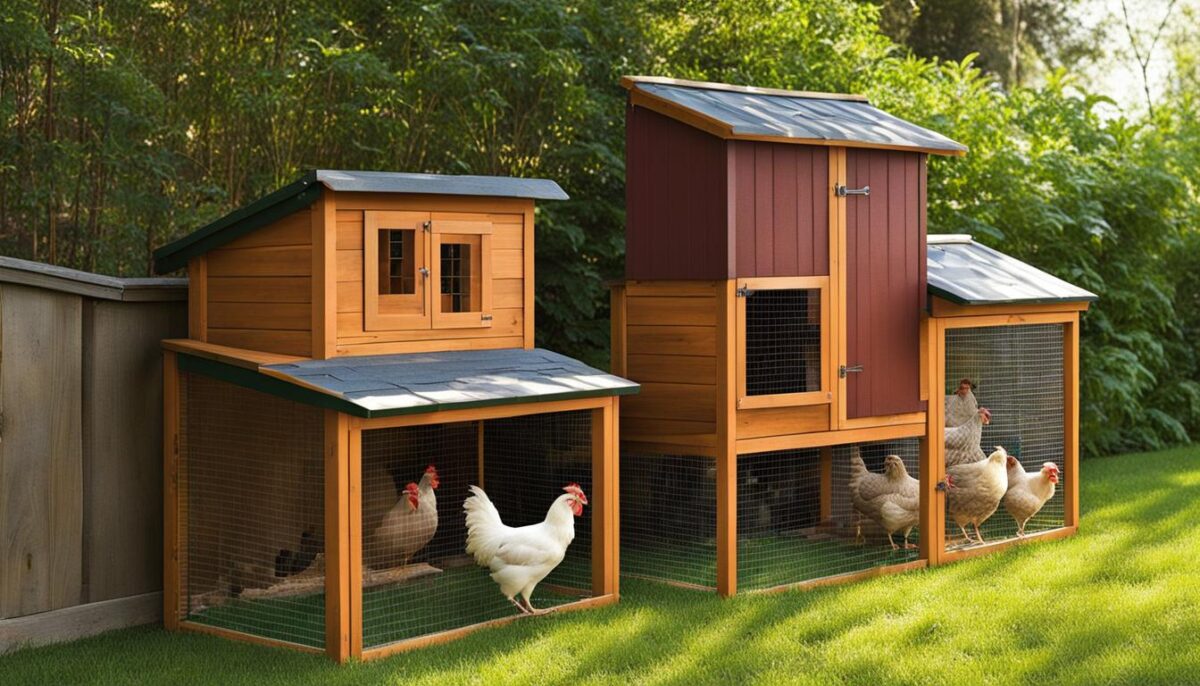
No matter which type of nesting box design you choose, it is important to ensure that they are well-constructed, easily accessible, and provide a comfortable and safe environment for your hens to lay their eggs.
Now that we have explored the different types of nesting box designs, let’s move on to discuss the appropriate sizing and requirements for nesting boxes in section 6.
Determining Nesting Box Size for Different Purposes
When it comes to providing nesting boxes for your chickens, it’s important to consider the specific needs for different purposes. Whether you’re looking to accommodate egg-laying or incubation, the size of the nesting boxes plays a crucial role in creating a comfortable and suitable environment for your hens.
Nesting Box Size for Egg Laying
For egg laying, it’s essential to choose nesting boxes that are appropriate for the size of your chickens. Different breeds have varying requirements, and providing the right-sized boxes can contribute to their overall well-being and egg-laying experience.
A recommended size for bantam breeds is 10″x10″x12″. Standard breeds would benefit from nesting boxes that measure 12″x12″x14″, while heavy breeds like Orpingtons may require larger boxes, measuring around 14″x12″x14″. These dimensions offer enough space for the hens to comfortably lay their eggs.
Nesting Box Size for Incubation
If you’re planning to use nesting boxes for incubating eggs, it’s crucial to provide ample space for the broody hen and her eggs. Larger nesting boxes create a suitable environment that promotes successful incubation.
For incubation purposes, it is recommended to have nesting boxes that measure around 14 inches square, with sides that are at least 16 inches tall. This size allows the broody hen to have enough room to sit comfortably on her eggs without risking damage or displacement. Additionally, having a lip at the front of the box helps prevent the eggs from rolling out.
By selecting the appropriate nesting box size for different purposes, you can ensure that your chickens have the necessary space and comfort they need for both egg laying and incubation.
How Many Hens per Nesting Box?
When it comes to determining the optimal number of hens per nesting box, there are a few considerations to keep in mind. For individual nests, the general recommendation is to have one nest for every 4-5 hens. This allows for enough space and privacy for each hen to lay her eggs comfortably. However, it’s important to note that some hens may have their favorite nesting box and may choose to lay there even if other boxes are available.
For a flock of 6 chickens, it is suggested to have at least 2 nesting boxes. This provides ample options for the hens to choose from and helps prevent overcrowding in a single box. The goal is to ensure that each hen feels comfortable and has easy access to a nesting box when it’s time to lay. By providing multiple boxes, you can reduce the chances of eggs being laid outside of the nesting boxes and increase the overall efficiency of egg collection.
If you’re using group nests instead of individual nests, the recommended nesting space is 9 square feet for every 100 hens. Group nests can accommodate multiple hens at once and make egg collection more convenient. However, it’s important to monitor the hens’ behavior and ensure that there is enough space for all the hens to access the nests comfortably. If you notice any signs of overcrowding or aggression, it may be necessary to provide additional nesting space to maintain a peaceful and productive laying environment.
| Number of Hens | Number of Nesting Boxes |
|---|---|
| 1-4 | 1 |
| 5-8 | 2 |
| 9-12 | 3 |
Table: Optimal Number of Hens per Nesting Box
DIY and Pre-Made Nesting Box Options
When it comes to providing your chickens with suitable nesting boxes, you have the option to either build your own or purchase pre-made ones. Both approaches have their advantages, so let’s explore each option in more detail.
DIY Chicken Nesting Box Plans
If you enjoy hands-on projects and have some basic carpentry skills, building your own nesting boxes can be a rewarding endeavor. There are many free DIY plans available online that provide step-by-step instructions and materials lists. These plans range from simple designs using recycled materials such as buckets or boxes to more complex options like rollaway nests or multiple box designs.
By building your own nesting boxes, you have the flexibility to customize them based on the specific needs of your flock. You can choose the size, design, and materials that best suit your chickens. Additionally, DIY nesting boxes can be a cost-effective option, especially if you already have some of the necessary materials on hand.
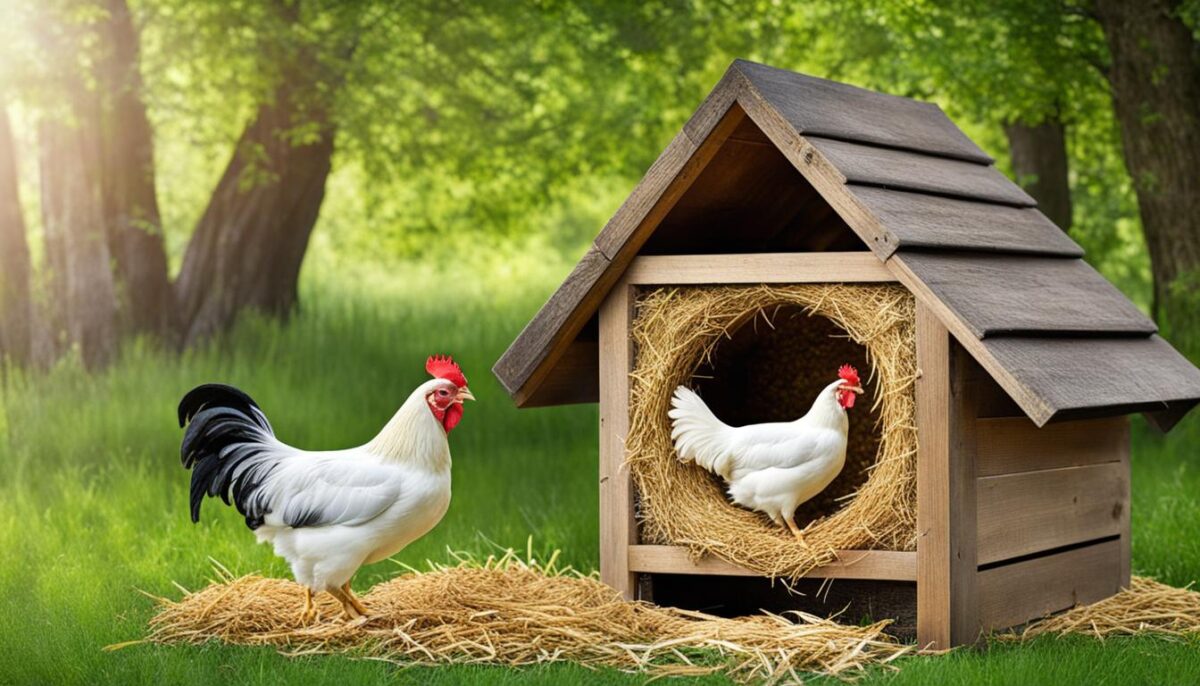
Pre-Made Chicken Nesting Boxes
If you prefer a ready-to-use option or don’t have the time or skills for a DIY project, pre-made nesting boxes are widely available for purchase. These boxes come in various sizes, designs, and materials to suit different flock sizes and preferences.
When choosing pre-made nesting boxes, consider factors such as the number of chickens in your flock, the size of your coop, and any specific features you may want, such as rollaway trays or perches. It’s important to select nesting boxes that provide adequate space and comfort for your chickens, allowing them to lay their eggs in a safe and secure environment.
| DIY Nesting Boxes | Pre-Made Nesting Boxes |
|---|---|
|
|
Whether you choose to build your own nesting boxes or purchase pre-made ones, the most important aspect is to provide your chickens with a comfortable and suitable space to lay their eggs. Consider the size, design, and features that best meet the needs of your flock, ensuring a cozy and inviting nesting area.
Best Practices for Nesting Box Placement
Proper nesting box placement is crucial for providing a comfortable and safe environment for your chickens to lay their eggs. By considering optimal placement, chicken coop layout, and nesting box location, you can ensure that your hens have a conducive space for their nesting activities.
Factors to Consider for Nesting Box Placement
- Quiet and Dark Area: Choose a location that is away from noisy areas and has minimal disturbance to create a calm environment for your hens.
- Safety and Security: Select a spot that is protected from predators and where your chickens feel safe. This will reduce stress and encourage them to use the nesting boxes.
- Avoid Direct Sunlight: Attach the nesting boxes to a south-facing wall or position them in a way that prevents direct sunlight from shining into the boxes. Direct sunlight can potentially damage the eggs and make the nesting boxes uncomfortable for the hens.
- Away from Feeders: Place the nesting boxes away from the feeding area to minimize disturbances and keep the nesting environment clean.
- Elevation: Elevate the nesting boxes 18-20 inches off the ground, ensuring they are lower than the roosting bars. This will discourage hens from roosting on top of the nesting boxes.
Chicken Coop Layout Considerations
When designing your chicken coop, it’s important to consider the layout to maximize the functionality of the nesting boxes. Position the nesting boxes in an easily accessible area, preferably near the entrance or a dedicated egg collection point. This will simplify the process of gathering eggs and promote efficient maintenance of the nesting area.
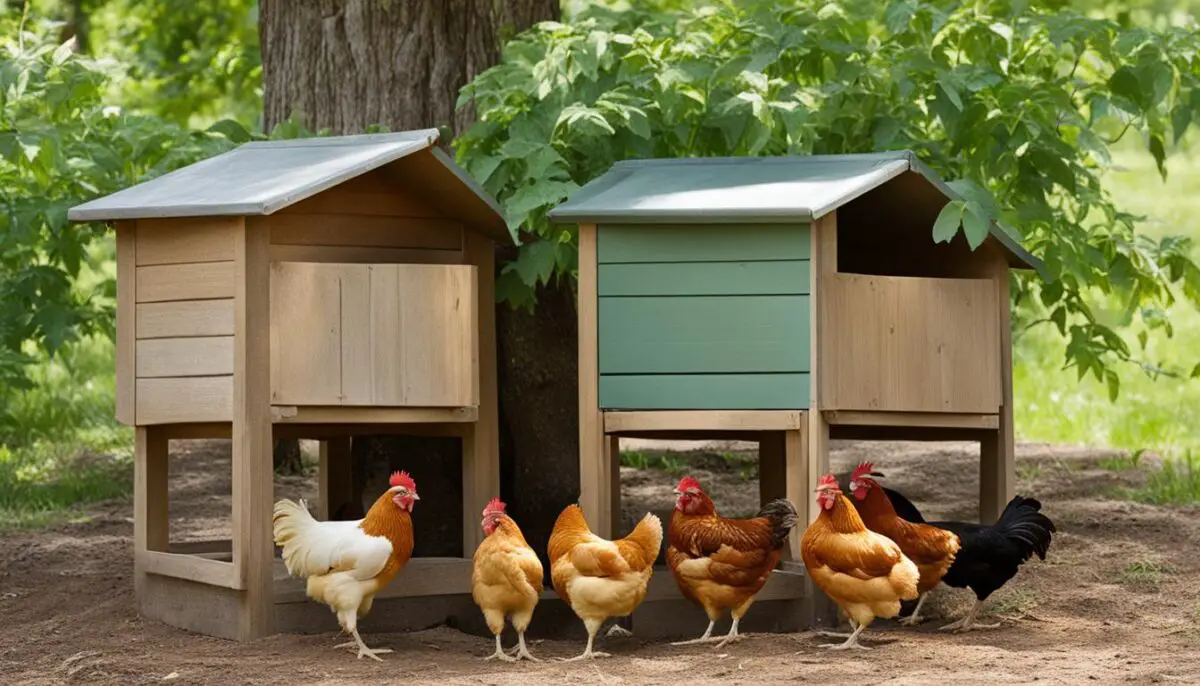
Visualized Example: Nesting Box Placement
| Nesting Box Placement | Advantages | Disadvantages |
|---|---|---|
| Inside the chicken coop, near the entrance | – Easy access for collecting eggs – Convenient maintenance of nesting area |
– May be subject to more activity and disturbances |
| In a separate area outside the coop | – Less disturbance for hens while laying – Provides additional space in the coop |
– Requires additional space and construction |
| Attached to an exterior wall of the coop | – Efficient use of space – Easy access for egg collection |
– Limited flexibility for coop layout changes |
Remember to monitor your chickens’ behavior and adjust the nesting box placement accordingly. Observing their preferences and making necessary modifications will ensure the optimal nesting environment for your flock.
Conclusion
Deciding on the quantity and size of nesting boxes for your chickens is essential to ensure their comfort and egg-laying needs. When determining the number of nesting boxes, consider factors such as flock size, breed, and individual preferences. A general guideline is to provide one nesting box for every three to four hens, but having a minimum of two boxes for a flock of six chickens is recommended.
The size of the nesting boxes should be appropriate for the size of your chickens. Standard-sized chickens typically require nesting boxes that are 12″x12″x12″ inches in size, but smaller breeds like Bantams can have smaller boxes, while larger breeds like Orpingtons may require bigger ones. Providing a dark and secluded environment for the hens to lay their eggs is important, and common bedding materials include wood shavings, hay, straw, grass clippings, and nesting box pads.
By following these guidelines for nesting box quantity and size, you can ensure that your chickens have comfortable and suitable areas for laying their eggs. Remember to consider the needs of your specific flock, as different breeds and individual hens may have their own preferences. With the right nesting boxes and proper care, your chickens will have a conducive environment to lay eggs and thrive.
FAQ
How many nesting boxes do I need for 6 chickens?
It is recommended to have at least 2 nesting boxes for a flock of 6 chickens.
What factors should I consider when determining the number of nesting boxes?
Factors such as flock size, breed, and individual preferences should be considered when determining the number of nesting boxes needed.
What size should the nesting boxes be?
The size of the nesting boxes should be appropriate for the size of your chickens. Common guideline sizes are 12″x12″x12″ for standard-sized chickens and 14″x12″x14″ for larger breeds.
What bedding material should I use for the nesting boxes?
Common bedding materials for nesting boxes include wood shavings, hay, straw, grass clippings, and nesting box pads.
How do I train chickens to use the nesting boxes?
To train chickens to use nesting boxes, create a dark and safe environment, place fake eggs in the nesting boxes to encourage laying, and gradually block access to unwanted places where the hens tend to lay.
What types of nesting box designs are available?
There are several types of nesting box designs to choose from, including individual nests, group nests, rollaway nests, and trap nests.
What size should the nesting boxes be for different purposes?
For egg laying, recommended sizes are 10″x10″x12″ for bantam breeds, 12″x12″x14″ for standard breeds, and 14″x12″x14″ for heavy breeds. For incubating eggs, larger nesting boxes are needed, with a size of 14 inches square and sides that are 16+ inches tall.
How many hens should share a nesting box?
For individual nests, it is recommended to have one nest for every 4-5 hens. For group nests, a minimum nesting space of 9 square feet should be provided for every 100 hens.
Should I build my own nesting boxes or buy pre-made ones?
You can choose to build your own nesting boxes using DIY plans available online, or purchase pre-made nesting boxes with added features such as rollaway trays and perches.
Where should I place the nesting boxes?
Nesting boxes should be placed in a quiet and dark area that feels safe for the hens, away from feeders and inside the coop. Elevating the nesting boxes 18-20 inches off the ground is ideal.
What should I consider when deciding on nesting box quantity?
When deciding on nesting box quantity, it is important to consider factors such as flock size, breed, and individual preferences to ensure that your chickens have comfortable and suitable nesting areas for laying their eggs.


